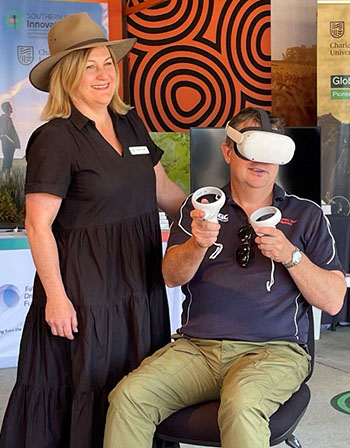November 2022
The Southern New South Wales Drought Resilience Adoption and Innovation Hub has brought significant investment into the region, through projects which have been activated on the ground with a range of industries.
They include collaborations focused on maintaining ground cover, promoting resilient pastures, optimising management of soil and water, managing biosecurity risks, creating resilient communities, capturing the value of AgTech, managing rangelands and creating longevity in perennial horticulture plants.
Working with the Farming Systems Groups Alliance, Local Land Services, NSW Department of Primary Industries (NSW DPI), Rural Aid and the region’s major universities, the investments involve thousands of farmers, agronomists, technology innovators, data scientists and scientists.
The project portfolio is in line with the Hub’s vision of connected and adaptable people and places, prepared to respond to future challenges and capitalise on opportunities.
Hub Director Cindy Cassidy says that the current floods have shown that investing in climate resilience is essential.
“We know that the impacts of things like floods and droughts are largely the same. We know that they happen in cycles and preparing for them is an essential part of business as usual,” she says.
“The projects and investments we are supporting will help the region manage the impacts of climate variability and recover more quickly when the cycle changes.
“Southern NSW Innovation Hub is investing in the knowledge, information flows and relationships that will help build genuine effective resilience into our landscapes, farms, businesses and communities.”
Significant investments include the $1 million Saving our soils during drought project to help farmers maintain groundcover across rested paddocks, so the soil can better endure and recover from drought conditions. Conducted by Holbrook Landcare Network, FarmLink Research, Central West Farming Systems, Riverine Plains, Soils Knowledge Network and Irrigated Cropping Council, it involves paddock trials and demonstrations at six separate locations. It aims to influence at least 400 farmers through field visits, workshops, publications, modelling and follow-up support.
There are further investments of almost $2 million in two related projects – Creating landscape-scale change through promotion of resilient pasture systems, led by Holbrook Landcare Network, and Optimal management of soils and available water led by Riverine Plains.
These explore a range of pasture management, pasture species selection and crop management techniques for improving soil health, increasing infiltration rates and water holding capacity, maintaining soil cover and improving nitrogen management practices. The goal is to help protect soils and productivity across 82 percent of NSW’s land area.
A further investment with NSW Local Land Services as the lead partner has resulted in the development of a virtual reality (VR) experience to help farmers design stock containment facilities to protect ground cover during drought.
The highly engaging presentation takes viewers on a virtual tour as two farmers talking about their containment facilities with interactive information highlights.
These projects are supported by the Southern New South Wales Resilience Adoption and Innovation Hub through funding from the Australian Government’s Future Drought Fund Drought Resilient Soils and Landscapes Program – Grants stream.
Another exciting initiative is two projects that are shared with other regional drought hubs around the country through the Drought Resilient Soils and Landscapes Cross Hubs Collaborative Projects program.
These include $183,333 being spent in the Southern NSW Hub region as part of a national project to protect Australia’s rangelands during droughts and $250,000 for the Southern NSW region, and a project studying drought management for perennial horticulture plants with the South Australian, Victorian and Tasmanian Drought Hubs.
The Hub is investing a further $2.5 million in projects that apply technology to regional resilience under the Agricultural Innovation Hubs Program. These include developing a track-and-trace type application to better manage biosecurity, which is currently being trialled by winemakers in the Canberra and Tumbarumba areas, and a calculator to predict the opportunity cost and benefits of investing in new agricultural technology for water, stock and land management that is being ground-truthed by a cohort of Southern NSW cattle farmers.
A third project explores how data could provide early warning of falling community resilience before, during and after extreme climatic events such as fire, drought or flood. The goal is to develop a guide that can be used by to identify communities under pressure and take early action.
“These projects, worth over $6 million in total, are a significant investment in the region’s environmental, economic and social future,” Ms Cassidy says.
“The Hub takes a holistic approach to building resilience, and we are putting just as much effort into regional relationships, communication and co-ordination.
“Our vision involves integrating better technologies, farming practices and support activities to improve how the region manages and recovers from future climate events.”
Led by Charles Sturt University, the Southern New South Wales Resilience Adoption and Innovation Hub is one of eight Hubs established through funding from the Australian Government’s Future Drought Fund.
More information is available at the SNSW Innovation Hub website.

Caption: Southern NSW Innovation Hub Director Cindy Cassidy watches Charles Sturt University’s Professor Christopher Blanchard exploring the Stock Containment VR experience – one result of the $6 million in investments supported by the Hub.
For interviews contact Kylie Dunstan, Communications and Engagement Manager, Southern NSW Innovation Hub on email kydunstan@csu.edu.au or phone 0417 437 922


